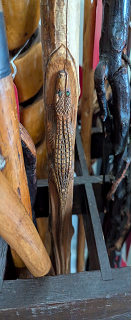Walking Sticks/Canes
Walking sticks and canes
The Cheshire Historical Society has an extensive collection of walking sticks. Canes reached peak popularity in Victorian England (1837-1901) and their popularity crossed “the Pond” to the United States. During this time, cane designs became more elaborate. However, by the middle of the 20th century, walking canes declined in popularity as a fashion accessory.
Article on how Cheshire Historical Society was gifted the walking sticks and canes
The inception of our collection was the 1956 donation of the collection amassed by Rev. John Davis Skilton. According to this article that appeared in the April 18, 1956 edition of the The Meriden Journal, that donation included three racks of over 500 canes. All of these canes were meticulously documented on index cards matched to numbered stickers affixed to each cane. Today, we have just one rack of canes, some of which were donated by other individuals.
But who was Rev. John Davis Skilton and what was his connection to Cheshire?
Rev. John Davis Skilton
Rev. John Davis Skilton
John Davis Skilton was born on March 18, 1867, in Ohio. However, the Skilton family had deep roots in Connecticut, specifically, Preston and Watertown. In 1904, John married Ida Beistle and the couple had three children, including John Davis, Jr.
After graduating from Divinity School, Rev. Skilton worked as assistant rector at St. Paul’s Rectory in Cleveland, Ohio, and then spent several years working in Nice, France. Upon his return to the U.S., Rev. Skilton served as headmaster for several academies, including the Cheshire School, now known as Cheshire Academy, where he was Head of School from 1907 until 1910.
After leaving Cheshire for other employment opportunities, he returned to serve as Rector of St. Peter’s Episcopal Church from 1924 until 1938. During this time, he was also Chaplain at Connecticut Reformatory. After he retired from his position at St. Peter’s, he, his wife and his son moved to Fairfield, CT. However, he continued to return to Cheshire to serve as the Chairman of the Cheshire Academy Board of Trustees during the 1940s. He also returned annually to participate in the Memorial Day Parade, where he and his cane headlined the parade.
Rev. Skilton died in Fairfield, CT on July 9, 1951, and is buried in Monroeville, Ohio. His son, John Davis Skilton, Jr. survived him.
John Davis Skilton, Jr.
John Davis Skilton, Jr.
John Davis Skilton, Jr. was born in Cheshire, Connecticut on February 28, 1909. He graduated from Cheshire Academy and later earned both a B.A. and an M.A. from Yale. After graduating from Yale, he worked as a curator at the National Gallery of Art in Washington, D.C. and in 1942 he assisted the National Gallery with the evacuation of its most important works of art to safety at the Biltmore Estate in Asheville, North Carolina.
In September 1943, Skilton enlisted in the U.S. Army and in early 1944 he was assigned to duty as an MFAA Officer in France. The Monuments, Fine Arts, and Archives Section Unit (MFAA) was a program established by the Allies in 1943 to help protect cultural property in war areas during and after World War II. It included about 400 service members and civilians who worked with military forces to protect historic and cultural monuments from war damage. Several of these individuals were portrayed in the 2014 film The Monuments Men.
Germany gives Top Honor to John Davis Skilton, Jr.
In August 1944, Skilton entered the town of Plougastel-Daoulas, France to inspect the remains of a small church destroyed during air raids. There he came upon a damaged monument known as The Calvary at Plougastel-Daoulas. Upon his return to the U.S., he founded the Plougastel Calvaire Restoration Fund, which paid for the restoration of the statues. In appreciation, the town named him an honorary citizen and named a town square in his honor.He was also responsible for the survival of the treasured Tiepolo ceilings of the Kaisersaal at the Würzburg Residenz in Würzburg, Germany.
In honor of his exemplary work in Würzburg, he was awarded the Verdienst Kreuz, First Class by the government of West Germany. He later received the Medaille de la Reconaissance Francaise and the French Legion of Honor. This Monuments Man died in Bridgeport, Connecticut on January 22, 1992.
From Our Collection Of Walking Sticks/Canes
Alligator carving gift
Rev. Skilton’s Collection #325 “Alligator carving gift from Geo. Clark, Cheshire Connecticut 19 October 1936”
Mexican Stick Coffee
Rev. Skilton’s Collection #91 “Mexican Stick Coffee (?) Marked ‘TIJUANA’”
Throttled sapling snake mottled
Rev. Skilton’s Collection #258 “Throttled sapling snake mottled. Bot at Wallingford, Connecticut. Made in Hospital – Hartford”
Orange from Florida 1902
Rev. Skilton’s Collection #30 “Orange from Florida 1902 Gift of Malpass Grubman”










